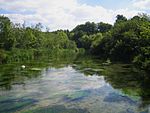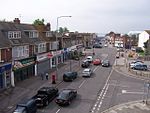Peartree Green
Areas of SouthamptonParks and open spaces in HampshireUse British English from February 2015

Peartree Green is an open space on high ground on the east bank of the River Itchen in Southampton. A 16/17th century building, Peartree House, still stands, though is today concealed by private housing. The house and the green take their name from a pear tree that grew near the parish church. Some of the original open space has been built on, but a large proportion remains as a recreational area. It contains a church and the remains of a boarding school. It overlooks the River Itchen to St Mary's Church in Southampton.
Excerpt from the Wikipedia article Peartree Green (License: CC BY-SA 3.0, Authors, Images).Peartree Green
Wharncliffe Road, Southampton Woolston
Geographical coordinates (GPS) Address External links Nearby Places Show on map
Geographical coordinates (GPS)
| Latitude | Longitude |
|---|---|
| N 50.904 ° | E -1.377 ° |
Address
Peartree Green
Wharncliffe Road
SO19 7GG Southampton, Woolston
England, United Kingdom
Open on Google Maps









